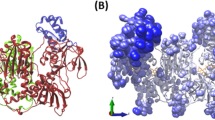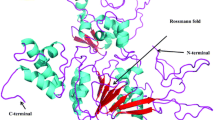Abstract
Schistosomiasis, a disease caused by helminth parasites of genus Schistosoma. Its treatment intensively depends on single drug, praziquantel which increases the risk of development of drug-resistant parasite. Inhibitors of human HDAC are profoundly reported as novel anti-cancer drugs and used as new anit-parasitic agents. Schistosoma monsoni class I HDACs are expressed in all stages of life cycle and indicating that this enzyme is most likely a major target for the designing specific inhibitors. In order to find novel target for the treatment of Schistosomiasis, three dimensional structure of SmHDAC1 was generated, using homology modelling. Features of the generated structure, was then deduced with respect to conformation of peptide backbone, local compatibility of the generated structure in terms of energy and molecular dynamics study. Considering these features of the generated structure, we selected all the class 1 inhibitors reported so far, which showed interactions with HDACs. Virtual screening was done using reported inhibitors (70) and using SmHDAC1 and HsHDAC1 as the targets. On the basis of binding affinity and IC50 value, 24th ligand was selected for the molecular docking purpose. In this study, out of all the reported inhibitors, 24th inhibitor (N,8-dihydroxy-8-(naphthalen-2-yl) octanamide zinc id- ZINC13474421) showed better binding with SmHDAC1 (−8.1 kcal/mol) as compared to HsHDAC1 (−6.4 kcal/mol) in terms of binding energy and supported by IC50 value. This paper throws light on the reliable model for further structure based drug designing, concerning SmHDAC1 of S. mansoni. Molecular docking studies highlighted advantages of comparative in silico interaction studies of SmHDAC1 and HsHDAC1. N,8-dihydroxy-8-(naphthalen-2-yl) octanamide can further use for the clinical trial.








Similar content being viewed by others
References
Brown M (2011) Schistosomiasis. Clin Med 11:479–482
Ross AG, Bartley PB, Sleigh AC, Olds GR, Li Y et al (2002) Schistosomiasis. N Engl J Med 346:1212–1220
Gray DJ, Ross AG, Li Y-S, McManus DP (2011) Diagnosis and management of schistosomiasis. BMJ 342:d2651
Domling A, Khoury K (2010) Praziquantel and Schistosomiasis. Chem Med Chem 5:1420–1434
Doenhoff MJ, Kusel JR, Coles GC, Cioli D (2002) Resistance of Schistosoma mansoni to praziquantel: is there a problem? Trans R Soc Trop Med Hyg 96:465–469
Kelly TK, De Carvalho DD, Jones PA (2010) Epigenetic modifications as therapeutic targets. Nat Biotech 28:1069–1078
Geutjes EJ, Bajpe PK, Bernards R (2011) Targeting the epigenome for treatment of cancer. Oncogene 31:3827–3844
Pierce RJ, Dubois-Abdesselem F, Lancelot J, Andrade L, Oliveira G (2012) Targeting schistosome histone modifying enzymes for drug development. Curr Pharm Des 18:3567–3578
Nwaka S, Hudson A (2006) Innovative lead discovery strategies for tropical diseases. Nat Rev Drug Discov 5:941–955
Lombardi PM, Cole KE, Dowling DP, Christianson DW (2011) Structure, mechanism, and inhibition of histone deacetylases and related metalloenzymes. Curr Opin Struct Biol 21:735–743
Andrews KT, Haque A, Jones MK (2012) HDAC inhibitors in parasitic diseases. Immunol Cell Biol 90:66–77
Mukherjee P, Pradhan A, Shah F, Tekwani BL, Avery MA (2008) Structural insights into the Plasmodium falciparumhistone deacetylase 1 (PfHDAC-1): a novel target for the development of antimalarial therapy. Bioorg Med Chem 16:5254–5265
Hompson JD, Gibson TJ, Plewniak F, Jeanmougin F, Higgins DG (1997) The ClustalX windows interface: flexible strategies for multiple sequence alignment aided by quality analysis tools. Nucleic Acids Res 24:4876–4882
Sali A, Blundell TL (1993) Comparative protein modeling by satisfaction of spatial restraints. J Mol Biol 234:779–815
Lerner MG, Carlson HA (2008) Apbs plugin for pymol. University of Michigan, Ann Arbor
Baker N, Sept D, Joseph S, Holst M, McCammon J (2001) Electrostatics of nanosystems: application to microtubules and the ribosome. Proc Natl Acad Sci U S A 98(18):10037
Lovell SC, Davis IW, Arendall WB, Bakker PIW, Word JM, Prisant MG, Richardson JS, Richardson DC (2002) Structure validation by Calpha geometry: phi, psi and Cbeta deviation. Proteins: structure. Funct Genet 50:437–450
Wiederstein M, Sippl MJ (2007) ProSA-web: interactive web service for the recognition of errors in three dimensional structures of proteins. Nucleic Acid Res 3:407–410
Vriend G, Sander C (1993) Quality control of protein models: directional atomic contact analysis. J Appl Crystallogr 26:47–60. WHAT IF Web Interface. http://swift.cmbi.kun.nl/WIWWWI/
Hünenberger PH, Mark AE, van Gunsteren WF (1995) Fluctuation and cross-correlation analysis of protein motions observed in nanosecond molecular dynamics simulations. J Mol Biol 252:492–503
Wang J, Cieplak P, Kollman PA (2000) How well does a restrained electrostatic potential (RESP) model perform in calculating conformational energies of organic and biological molecules? J Comput Chem 21:1049–1074
Jorgensen WL, Chandrasekhar J, Madura JD, Impey RW, Klein ML (1983) Comparison of simple potential functions for simulating liquid water. J Chem Phys 79:926–935
Essmann U, Perera L, Berkowitz ML, Darden T, Lee H, Pedersen LG (1995) A smooth particle mesh Ewald method. J Chem Phys 103:8577–8593
Hess B, Bekker H, Berendsen HJC, Fraaije JGEM (1997) LINCS: a linear constraint solver for molecular simulations. J Comput Chem 18:1463–1472
Noureen N, Rashid H, Kalsoom S (2012) An efficient anticancer histone deacetylase inhibitor and its analogues for human HDAC8. Med Chem Res 21:568–577
Trott O, Olson AJ (2010) AutoDock Vina: improving the speed and accuracy of docking with a new scoring function, efficient optimization and multithreading. J Comput Chem 31:455–461
Sanner M (1999) Python: a programming language for software integration and development. J Mol Graph Model 17:57–61
Delano WL (2002) The PyMol molecular graphics system. DeLano Scientific, Palo Alto
Wallace AC, Laskowski RA, Thornton JM (1995) LIGPLOT: a program to generate schematic diagrams of protein–ligand interactions. Protein Eng 8:127–134
Millard CJ, Watson PJ, Celardo I, Gordiyenko Y, Cowley SM, Robinson CV, Fairall L, Schwabe JW (2013) Class I HDACs share a common mechanism of regulation by inositol phosphates. Mol Cell 51:57–67
Frishman D, Argos P (1995) 75 % accuracy in protein secondary structure prediction. Proteins 27:329–335
Nardini M, Dijkstra BW (1999) α/β Hydrolase fold enzymes: the family keeps growing. Curr Opin Struct Bio 9:732–737
Roy S, Packman K, Jeffrey R, Tenniswood M (2005) Histone deacetylase inhibitors differentially stabilize acetylated p53 and induce cell cycle arrest or apoptosis in prostate cancer cells. Cell Death Differ 12:482–491
Irwin Sterling (2012) Mysinger, Bolstad and Coleman. J Chem Inf Model 52(7):1757–1768
Acknowledgments
This is my PhD work, supported by University Grant Commission, New Delhi, India. We thank, Dr. Navneet Mishra for is valuable suggestions, Mr. Surya Pratap singh for his critical reading and scientific discussions, and Miss Pallavi Gaur for editing the manuscript and Miss Swadha Singh for critical reading of early versions of the manuscript. Constructive comments from them helped us to make the manuscript more accurate. We apologize to our colleagues whose relevant work has not being cited because of the space limitations.
Author information
Authors and Affiliations
Corresponding author
Electronic supplementary material
Below is the link to the electronic supplementary material.
11033_2014_3816_MOESM1_ESM.tif
Figure S1. a, b, c, d and e represent geometry of Metal binding domain of modeled SmHDAC1 and human Class I HDACs respectively. HDAC has Zn2+ ion (cofactor) in the catalytic site, which is bound to three amino acid (two aspartic acid and one histidine) residues. (TIFF 2118 kb)
11033_2014_3816_MOESM2_ESM.tif
Figure S2. Ramachandran plots of Human HDAC1(4BKX) and SmHDAC1. SmHDAC shows numbers of residues in favoured region are 311(96.0 %), in allowed regions are 11(3.4 %) and in outliers is 2 (0.6 %) Numbers of residues in favoured region are 349(95.1 %), in allowed regions are 17(4.16 %) and in outliers is 1 (0.3 %). Ramachandran plot of SmHDAC1 shows satisfactory result while comparing with HsHDAC1 (3BKX).(TIFF 391 kb)
11033_2014_3816_MOESM3_ESM.tiff
Figure S3. Upper left to right panel represent Z-score plot, representing Z-score values of proteins (resolved by NMR and X-ray and submitted in PDB). In this plot two dark black points represent Z-scores of the modeled protein template HsHDAC1 (PDB ID: 4BKXB) and SmHDAC1 respectively. In lower panel, left to right represent knowledge based energy profile of the modeled SmHDAC1 in comparison to the crystal structure of human HDAC1 (4BKXB). The trend of the variation of the protein folding energy in SmHDAC1 model is in good harmony with that of the crystal structure of human HDAC1 (4BKXB). (TIFF 8779 kb)
11033_2014_3816_MOESM5_ESM.tif
Figure S5 Radius of gyration for SmHDAC1. The x-axis represents the time in ps and y-axis represents radius in nm. (TIFF 163 kb)
11033_2014_3816_MOESM6_ESM.tif
Figure S6. (A) Superimposition of SmHDAC1 and crystal structure of HsHDAC1 (PDB id: 4BKX) both structures adopt almost similar fold pattern. Spheres represent Zn ion and K ions. (B,C) SmHDAC1 (HsHDAC1), helices are represented by green (red), beta sheaths are in pink (purple), metal ions are presented in purple colour (Zn++ ion comparatively smaller than K+) and turns are presented in gray colour. Their catalytic zinc ion is found at the same position. (TIFF 4034 kb)
11033_2014_3816_MOESM7_ESM.tif
Figure S7. Trajectory of backbone atoms (RMSD) of SmHDAC1 with snapshot 2 ns time steps. Stability of inter- and intra-domain movements in SmHDAC1 were analysed in terms of RMSD fluctuation of backbone atoms and were found to be small in the system studied. (TIFF 2156 kb)
11033_2014_3816_MOESM8_ESM.tif
Figure S8. Secondary structure and fold comparison between homology model and X-ray structure of SmHDAC1(B) and HsHDAC1(A) respectively. E: β-strand, H: α-helix, T: turn, G: 310-helix, B: breaker. (TIFF 305 kb)
11033_2014_3816_MOESM9_ESM.tif
Figure S9. (A)Residue-wise RMSF profiles of the SmHDAC1 and DSSP analysis (B,C). There are two major fluctuating regions are present in SmHDAC1. From residue number 45-52 and 266-293. These are the parts of loop regions. Band C represent transition states of of secondary structure over the simulation of 10 ns time period. (TIFF 1061 kb)
Rights and permissions
About this article
Cite this article
Singh, R., Pandey, P.N. Molecular docking and molecular dynamics study on SmHDAC1 to identify potential lead compounds against Schistosomiasis. Mol Biol Rep 42, 689–698 (2015). https://doi.org/10.1007/s11033-014-3816-z
Received:
Accepted:
Published:
Issue Date:
DOI: https://doi.org/10.1007/s11033-014-3816-z




